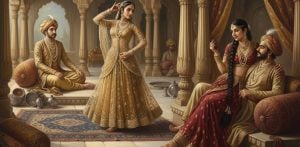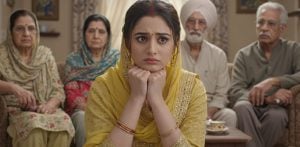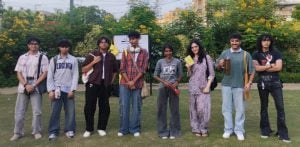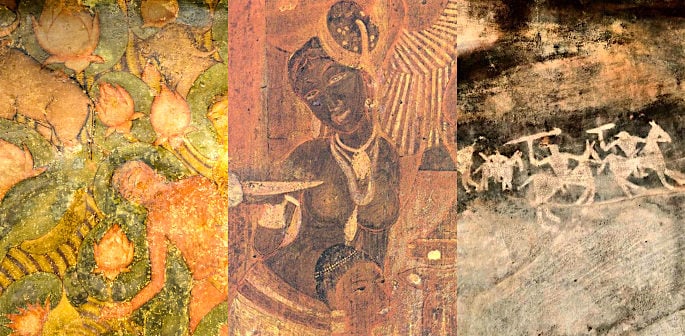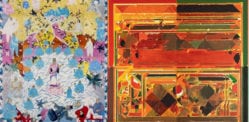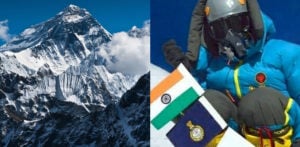Adventure seekers can trek their way up the cave.
Cave paintings in India date back to pre-historic times. The human race depicted their thinking, emotions and routine life through pictorial representation by way of cave paintings and sculptures.
It is rightly said that eyes are windows to the soul and artisans of the pre-historic era expressed it eloquently through their paintings, few of which have now become a heritage site.
Archaeologists believe that most of these art forms existed during Palaeolithic, Mesolithic and Chalcolithic phases.
Some others date further to early historic and medieval period, thereby providing an insight into the progressive behaviour of humans.
Caves being home to such artisans – these paintings were drawn on rocks and in the interior part of the caves.
Away from materialistic pleasures, they showcased their talent with minimalistic resources.
Natural resources were enough to turn the cave walls into a canvas, minerals and vegetable oils into paint – not to forget the exemplary imagination skills that have contributed to creating history.
DESIblitz lists the top 10 cave paintings in India which portray distinct stories illustrating the glimpse of Indian traditions and culture practised in distinct parts of the country.
Bhimbetka Rock Shelters
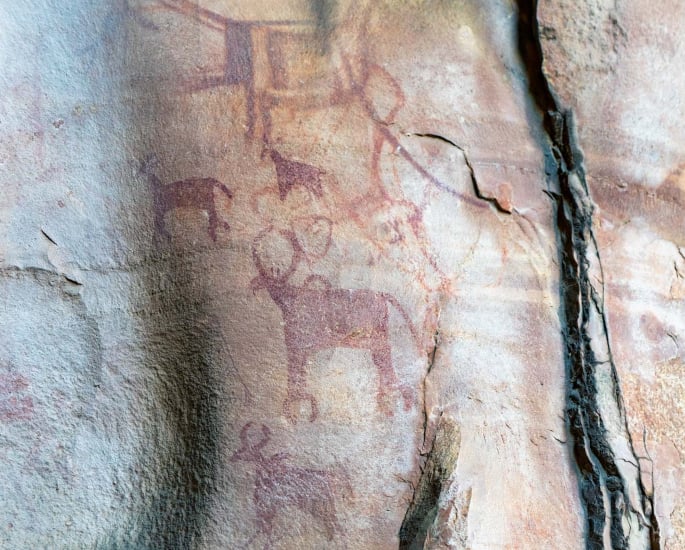
Located in Madhya Pradesh, Bhimbetka Rock Shelter lies on the foothills of The Vindhyan range, about 50 km from Bhopal – the capital city of the state.
Named after ‘Bhima’ – one of the five Pandavas of Mahabharata, Bhimbetka means the ‘sitting place of Bhima’.
Dr. Vishnu. S. Wakankar was the first archaeologist to discover this gem in 1957. The intriguing and aesthetic structure was declared as a World Heritage Site by UNESCO in 2003.
Nestled amidst dense forests and waterways of Ratapani Wildlife Sanctuary, the 10 km stretch of the site comprises of about 700 rock shelters – of which 243 have been discovered so far.
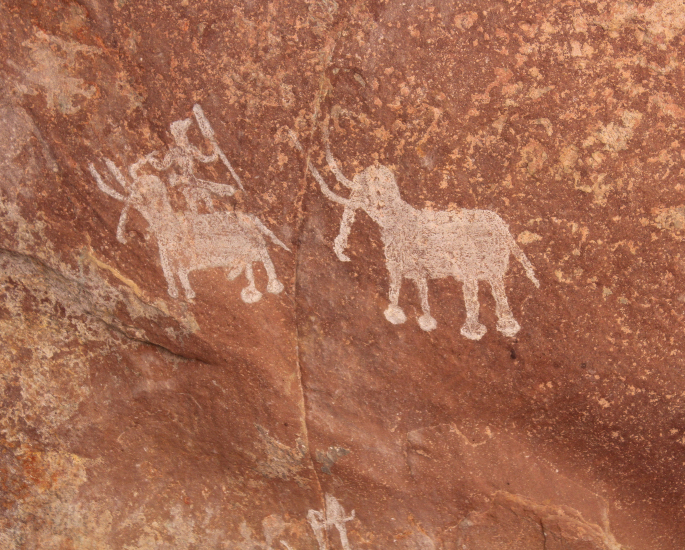
Only 15 caves are open for tourists. Although the number may seem small, there are plenty to witness. By far, the Auditorium cave and Zoo Shelter cave are the most artistically impressive cave shelters at the site.
The elegant cave paintings depict the lifestyle of different troops of people – ranging from Mesolithic to the Medieval period. This clearly explains the evolution of mankind over thousands of years.
Inscriptions are mostly monochromatic i.e. painted in white and red. Cave paintings in the rock shelters reproduce stylish, graphical, geometrical and decorative patterns. These designs have retained their relevance even today.
Bimbhetka Rock Shelter has few of the oldest cave paintings in India that describes not just lifestyle but also pictures culture, animals and celebration of events.
Tourists on Tripadvisor describe this marvel as: “A Hidden treasure” and “A Must Visit – Great Historical Site!”
Ajanta Caves
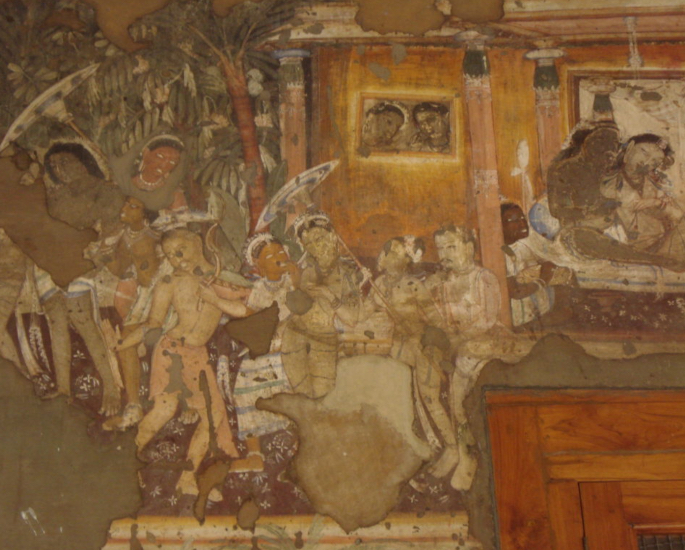
A UNESCO Heritage Site, the paintings at Ajanta caves tell a story about the life of Buddha and his religious teachings. Artworks predominantly represent the relevance of Jataka tales.
Sited in Aurangabad district of Maharashtra, amidst the forest, mountains and Waghur River flowing alongside, the heritage site comprises of 30 caves – once home to Buddhist monks.
Discovered by Britishers in 1819, archaeologists later scrutinised that the cave was built in two phases.
The first was built around 2nd century BC to 1st century BC, while the second phase saw impeccable addition to paintings and sculptures during the 5th and 6th century AD.
A researcher, who also shows a keen interest in interpreting the Ajanta paintings, concludes that:
‘Religion was not a criterion for appointment as a painter.’
Preference was solely given to families that had been painters for generations. She exemplifies her study by emphasising on a painting of a Brahmin performing puja in one of the caves.
Exceptional with its techniques in the history of South Asian art, the cave walls were chiselled to hold a plaster made of clay, hay, cow dung and lime.

The colours were a combination of plants, vegetables, stones and minerals, which were applied on wet plaster so that it wouldn’t chip off easily.
Exciting facets of human emotions like greed, jealously, love and compassion are depicted in the paintings. Interestingly, every cave painting has a different story to tell, making each inimitable!
The graphic techniques of fine brush strokes, traces of refined contours, firm lines, accentuating anthropoid features like eyes, nose, lips, chin making the figures stand out is sure to leave you spellbound.
The extravagant artisans have not shunned away from displaying everything beautiful that their eyes have ever been exposed to.
From paintings of features, ornaments, hairstyles to birds and animal behaviour, flowers and architecture, a history buff is sure to love it all.
Tourists from around the world have embraced the beauty of this cave. One of them describes it on Tripadvisor:
“Must visit UNESCO Heritage. Gem of India.”
Ellora Cave Paintings
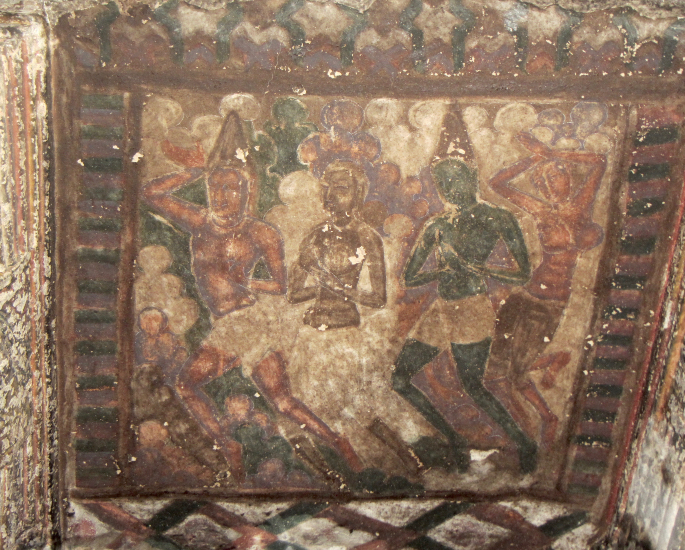
Volcano eruption in the earlier flat region gave rise to multi-layered basalt formations, thereby making it convenient for artists to showcase their artwork in this structure of Ellora caves.
The UNESCO Heritage site is acknowledged for its breathtaking Kailasa temple – a chariot shaped monument, devoted to Lord Shiva. It is the largest monolithic rock excavation in the world.
Out of a total of 100 caves present within an area of about 2 km, tourists have access to 34. A sister monument to Ajanta caves, the architectural beauty lies in the Aurangabad district of Maharashtra.
The painting style adopted in Ellora is similar to Ajanta caves i.e. Tempera.
It is one of the few cave paintings in India that has incorporated Hindu, Buddhist and Jain concepts under a single roof. This conveys secularism persisted even during the period between the 2nd to 11 centuries AD.
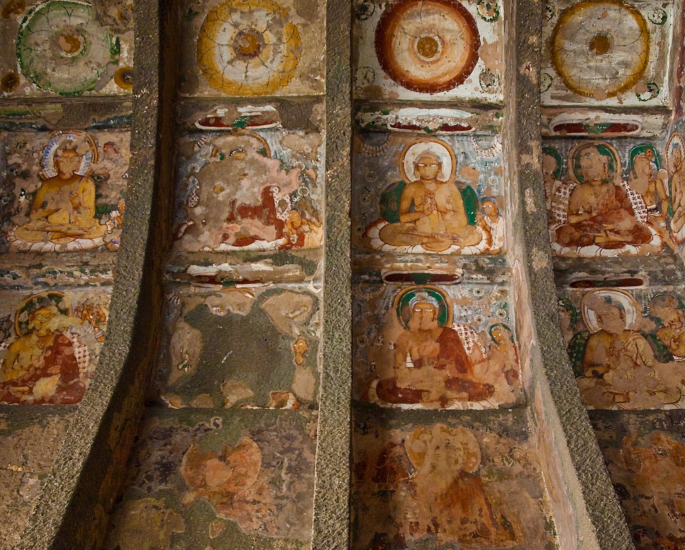
The 12 caves that came into existence during the Buddhist era encompass the paintings giving an outline of the life of Buddha and his spiritual practices.
Five caves represent Jainism – of which, the Indra Sabha is renowned. It houses the single rock shrine of Lord Mahavir. The murals in Jain temples are also worth seeing.
Lack of maintenance has destroyed the paintings to a large extent.
Ellora’s best safeguarded paintings lie in the cave of Kailasa temple. Archaeologists have proclaimed that these paintings were drawn in two phases.
The first phase characterises the images of Lord Vishnu and Goddess Lakshmi. The second phase portrays the procession of Shaivites. The paintings of flying apsaras are aesthetically appealing.
During winters, MTDC (Maharashtra Transport Development Corporation) organises a cultural event known as the Ajanta Ellora festival which cannot be a miss!
Bagh Cave Paintings
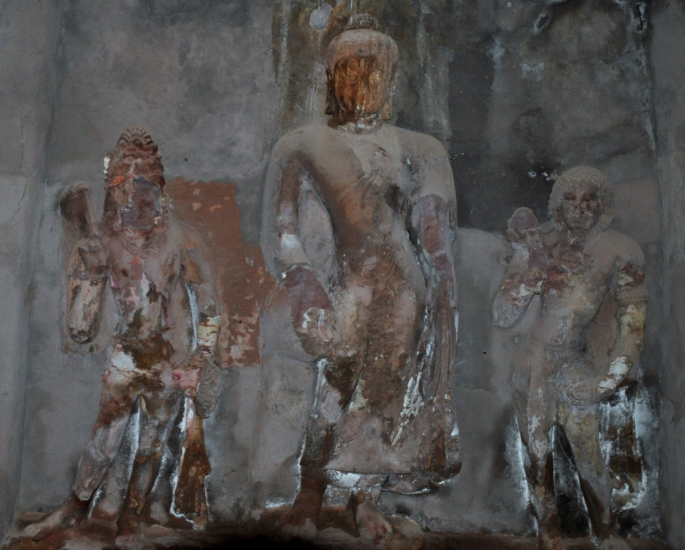
On the banks of a seasonal rivulet, the Baghani lies the rock-cut monument on the southern slope of The Vindhyas. The Bagh Caves dwell in the western region of the state of Madhya Pradesh.
Inspired by Buddhist values, the caves are maintained by the Archaeological Survey of India (ASI) for almost 2 decades.
It is most likely believed that the Bagh cave paintings belong to the 5th or 6th century AD during the supremacy of the Satavahana dynasty.
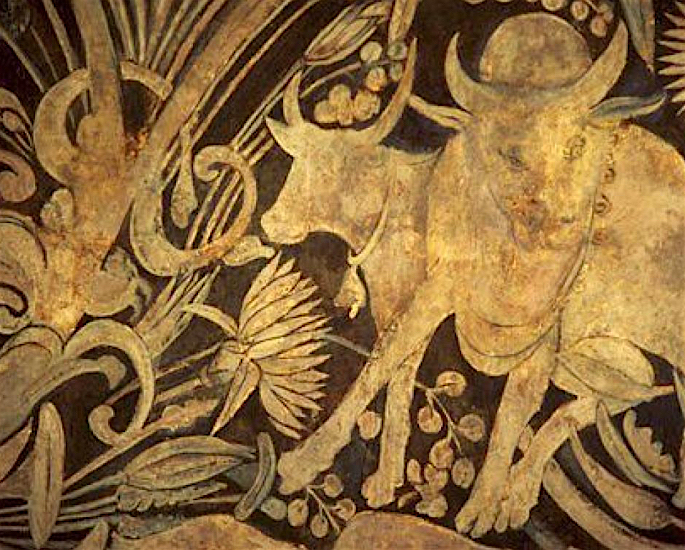
Peer to renowned Ajanta caves, the ASI has managed to retain five caves out of nine. The style and techniques of painting used are also similar to that of the Ajanta caves.
Amongst some of the best cave paintings in India, the mural art visualised in Bagh cave is outstanding. These give a glimpse of the skilled talent of classical dancers, musicians and artisans alike.
Beautiful images of Bodhisattvas and Buddha preaching are also depicted in these paintings with lovely features adding colours to it.
Abode to several Buddhist monks during the era, the paintings of Cave 4, commonly known as the Rang Mahal will fill your heart with joy!
Jogimara Cave Paintings
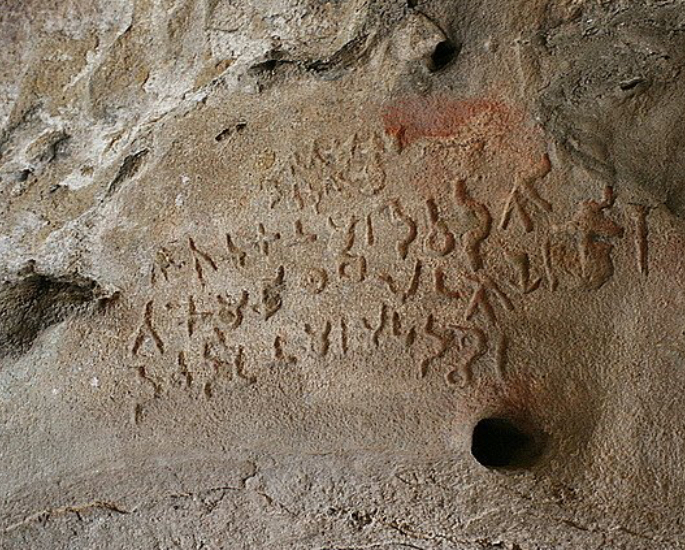
Positioned around the Narmada river, amidst the massive mountains and jungle, lies the enchanting Jogimara cave. It shares its entrance with the Sita Bengra cave.
The entrance to this beauty is known as Hathipol – which means Elephant cave. The tunnel is 55 meters long and wide enough for an elephant to pass through.
During the exile of Ram-Sita, the Sita Bengra cave was believed to be the residence of Sita. Jogimara cave, on the other hand, is a small rock chamber filled with ecstatic paintings and inscriptions.
Coated with a white base plaster – mainly red, black, white and yellow colours are used. Each painting is adorned with a red outline.
Oldest surviving cave paintings in India, the doorway of Jogimara cave is ornamented with seven paintings primarily picturing a couple in love, singers, dancers, fish and elephant figures.
The images of saints, animals, birds and chariot paintings are also mirrored on the walls, few of which have lost clarity and lustre.
Inscriptions convey a love story. The story is about Sutnuka who was a performer in the theatre and Devdutta, who admired Sutnuka for her poise and grace.
The exchange of love messages between the two gave way to Brahmi script and the art of calligraphy.
Lenyadri Caves
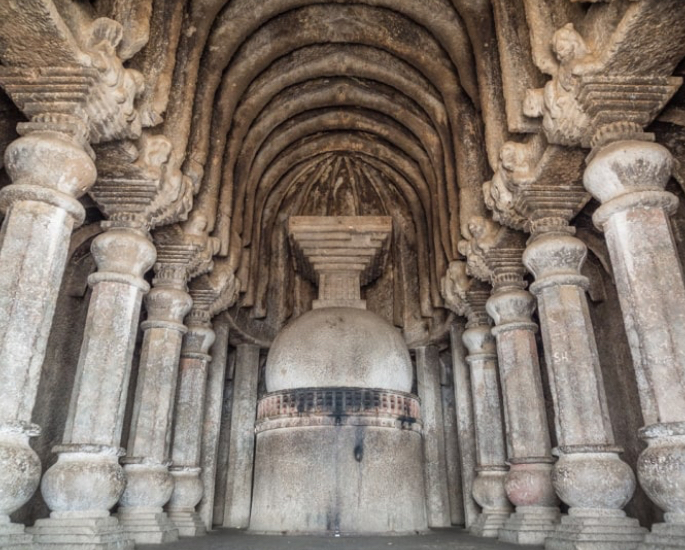
Lenyadri caves were originally built as a Buddhist monastery during the 1st century AD to 3rd century AD.
One of the 40 caves of Lenyadri is revered as the birthplace of Lord Ganesha. This cave temple of Girijatmaj is among the eight Ashtavinayaka shrines.
Overlooking the catchment area of River Kukdi and surrounded by lush green surroundings, the cave paintings in Lenyadri is a true gem in Pune district in the state of Maharashtra.
Mainstream paintings comprise Buddhist paintings, carved decorations of lotus, geometric patterns and concentric circles.
The paintings also display life scenes of Hinduism.
In the 19th century, the temple cave was embellished with paintings reproducing the sphere of Ganesha’s life – childhood, Hallisaka dance, marriage preparations and battle with demons.
The calligraphic inscriptions on the pillars of the cave are extravagant.
Sittannavasal Cave Temple
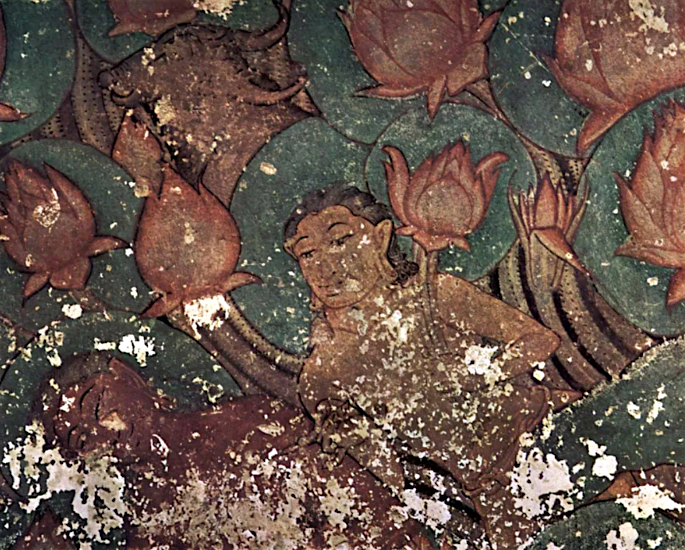
Situated in a small town of Pudukkottai district in Tamil Nadu, Sittannavasal cave cut temples are home to pure relics of mural paintings representing Jainism.
Familiarly known as, ‘The Ajanta of Tamil Nadu’, the temple is a 2nd century Jain complex of caves. It is also one of the earliest cave paintings in India as far as Jain culture is concerned.
The technique applied in these paintings is fresco-secco. The mesmerising colourful murals are painted with vegetable and mineral dyes.
Mainly, the paintings revolve around the era of the Pandyan reign with portraits of voluptuous dancing women, a beautiful couple, intricate flower designs, birds, animals and illustrations of the Jain Tirthankaras.
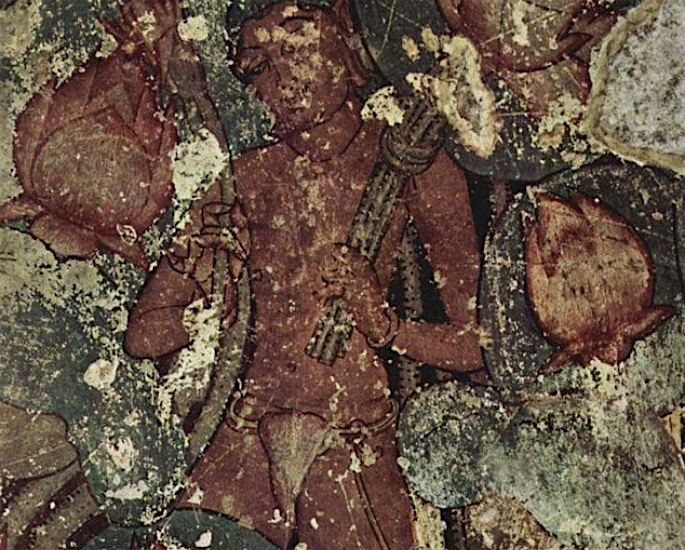
The significant artworks depicting the theme of Samavasarana can be found in the regions of sanctum and Ardha-mandapam inside the temple. Pillared veranda, inscriptions and ceiling are few other notable areas.
At first sight, the artwork in Sittannavasal caves may seem to be a replica of eminent Ajanta caves. Silpa Sastras have explained the uniqueness of materials used in both the paintings.
Silpa Sastra is a Sanskrit term, used in Hindu texts for the purpose of describing rules, principles and standards for art and craft.
Due to lack of maintenance, the cave paintings have been wrecked. Despite the disfiguration, the site still finds its place in the list of ‘Must See Indian Heritage’ issued by ASI.
A traveller has reviewed the paintings of Sittannavasal Cave as, ‘Cave with great paintings” and “Acoustic Marvel and a slice of History.”
Badami Caves
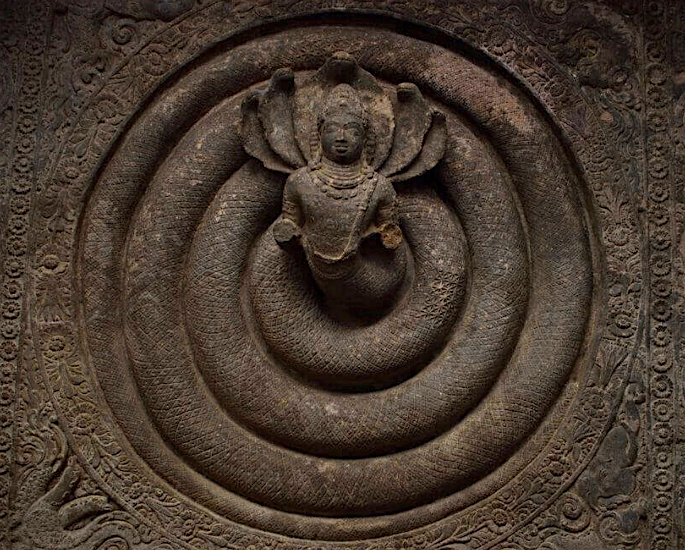
Badami caves are one of those cave paintings in India that are largely influenced by Hindu and Jain religion.
Carved and painted mostly during the 6th and 8th centuries, it is located in the Bagalkot district of Karnataka.
Having close resemblance to the Ajanta paintings, the mural paintings of Badami caves are the earliest surviving exhibits. The monuments at Mahabalipuram take inspiration from their artwork.
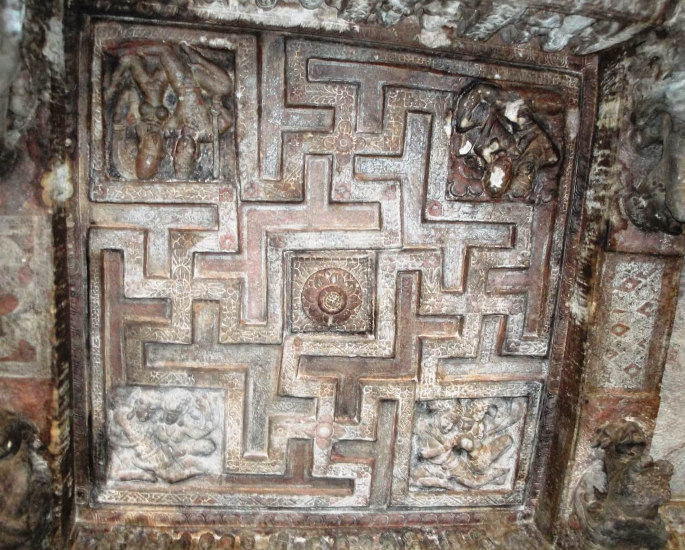
The paintings of Hindu ideology represent the stories from Puranas and massive images of Lord Vishnu avatars like Paravasudeva, Bhuvaraha, Harihara and Narsimha.
The ceilings are festooned with four-armed Lord Brahma seated on his swan, drawings of Lord Shiva and Goddess Parvati. Paintings of Jain ideology include Lord Mahavira and Jain Tirthankaras.
Apart from captivating paintings, the sculptures and carvings in each cave is a true jewel.
‘Enchanting’, ‘Unbelievable’, ‘Wow!’ are adjectives used by visitors on Tripadvisor defining their journey to the caves.
Saspol Cave Paintings
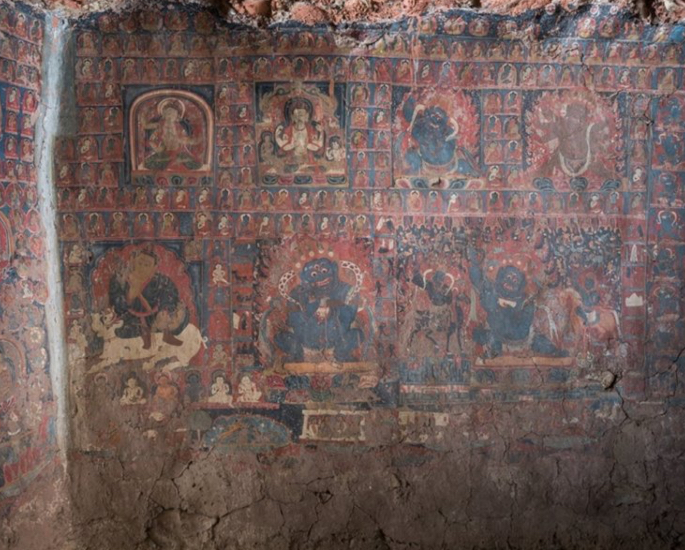
Cave temples are an unusual sight in Ladakh. Hidden between the rocks and hills, lies the Saspol cave in Ladakh, Jammu and Kashmir. The paintings here date back to 15th century AD.
The cave paintings in Saspol cave are a blend of Tibetan and Indian Buddhist art. They are quite simple as compared to the ones in Central and South India.
One can view the Indus valley from the caves.
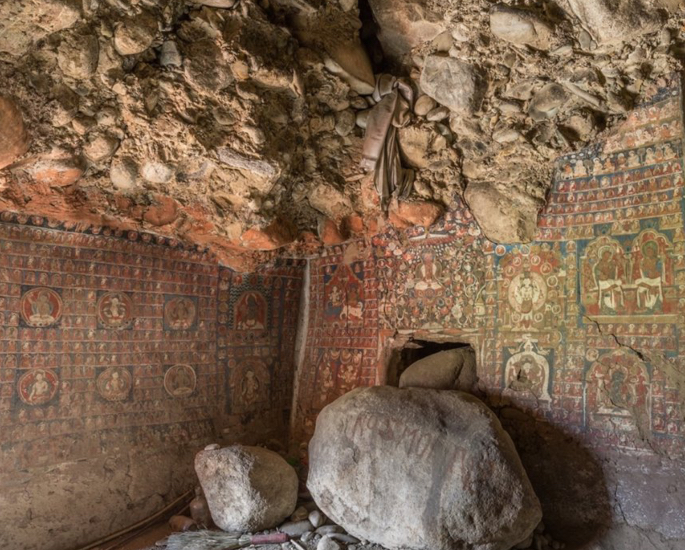
Walls are designed with miniature paintings of Buddhist deities. It is an informative resource to comprehend the Buddhist history and the Buddhist thoughts practised in this region.
Portraits of Hevajra – one of the ishta devas, who was a fully enlightened being and Samvara – guardian deity are appealing miniatures.
Due to the fear of impairment as a result of sagging, the monument has been supported by World Monuments Watch since 2016.
Adventure seekers can trek their way up the cave. Adjectives used by visitors are “Caves Hiding Treasures” and “Mind-blowing” to name a few.
Adamgarh Rock Shelters
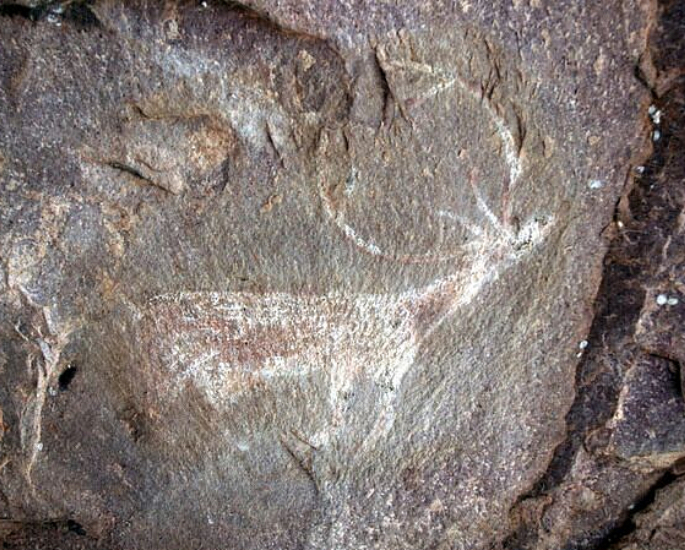
Excavated by Mr. Manoranjan Ghosh in 1922 CE, Adamgarh rock shelter is geographically located near Narmada river in the state of Madhya Pradesh. The structure supremely highlights miniature paintings.
Unlike other cave paintings in India, these paintings are very simple and not intricate. Painted in vivid shades of red, brown and white, they are surely a sight to see.
Amongst 18 rock shelters, the paintings of different animals, birds and humans can be distinctly identified in 11 rock shelters.
Human figures are merely represented by outlines unlike those of animals and certain birds, which are more detailed.
Human illustrations include men fighting with swords, bows and arrows, a man hunting a bull, battle scenes, men in running position and soldiers riding on horseback.
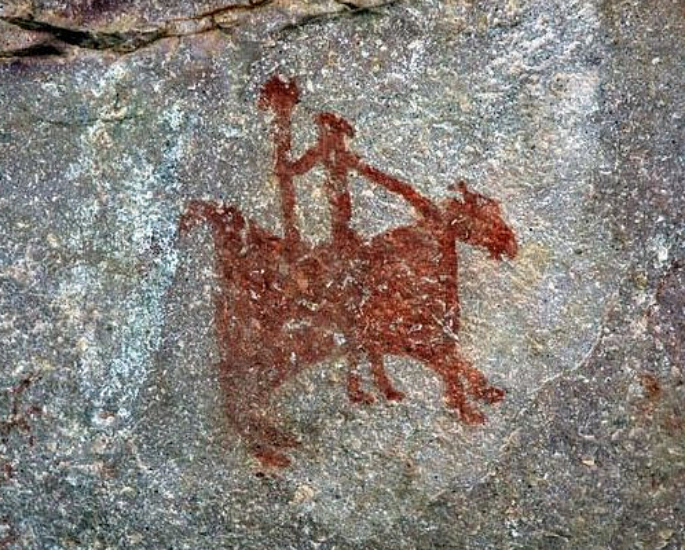
Different moods of animals like bulls, cows, horses, monkeys, giraffe, spotted deer, elephants are figured. Peacocks and fishes also form part of the clan.
They say, ‘There is beauty in simplicity’. After visiting this rock shelter, you will know why.
Going through the above list, it is understood that paintings have a language of their own. It doesn’t matter which period they belonged to. Every artist had a story to convey.
Even though most of these structures are under the custody of ASI now, as a visitor we can ensure that we don’t hamper these priceless artefacts.
Such relics not only offer us amazing lessons, but they will also be valuable for generations to come and for the country as a whole.










































